Barrier Dunes are the most protected coastal resource in Massachusetts. Barrier Dunes perform in the Public Interest by providing flood control, storm damage protection and habitat values. Barrier Dunes are surprisingly fragile because they are only held together with a thin layer of native vegetation, which is highly susceptible to human transit. For these reasons and others, they are nearly impossible to restore.
Ballston Beach Barrier Dune Restoration, Truro, Cape Cod
A unique Community Restoration Partnership has been created in Truro on Cape Cod: Truro Beach Commission; Truro Department of Public Works; National Parks Service, Cape Cod National Seashore; Truro Conservation Commission;Friends of the Cape Cod National Seashore; Truro Non Resident Taxpayers Association and Safe Harbor Environmental.
If you are willing to make a small donation for beach grass plugs, to support sustainable restoration of this resource area, your tax deductable donation should be made out to FCCNS with Ballston in the memo line. They should be sent to FCCNS at PO Box 550, Wellfleet, MA 02667. Bundles of 300 stems cost $39.00. Any size donation contributes to this project.
If you are interested in volunteering to plant beach grass plugs or assist in setting up sand collection fence, please email goronpeabody@gmail.com
The following is the first article that I have written about this project. There were a lot of components that were brought together for this restoration. It has been published in a Cape Cod magazine this summer. Click on the link below to read it.
CHA_Summer11_BallstonBeachArticle
I watched in fascination as the only pair of nesting ducks, living in what used to be a fresh water marsh, walked out to a beach parking lot to drink rainwater from a puddle. I remember thinking, “We can do better than this.” ”We need to make better choices because children are going to inherit our decisions.”.
Barrier dunes are among the most fragile and easily damaged coastal resource in Massachusetts. The barrier dune on the ocean side at Truro’s Ballston Beach protects the freshwater marsh at the headwaters of Truro’s Pamet River. The river flows from the marsh across the thin wrist of the Cape and into Pamet Harbor on Cape Cod Bay. The Pamet River estuary provides legendary oyster and shellfish habitat. When we view natural resources as systems, we begin to understand that everything is connected. The health of the marsh behind the barrier dune is linked to the health of the estuary and harbor.
There was no way for visitors to have understood that crossing this barrier dune to get to the beach would destroy the freshwater marsh behind it.
Vegetation stabilizes dunes by collecting and holding sand. Dune grass can withstand 80 mph winds but dies when it is walked on. Without vegetation, storm winds quickly strip off sand and lowering pathway elevations six or eight feet. This allows ocean storm over wash to degrade the fresh water marsh with salt water. Storm energy is a natural component of coastal resource systems and storm over wash is part of these processes. But this marsh system was being impacted every few years breaking down the stability of the area before it could repair itself.
What makes an entire Cape Community come together in an environmental intervention? As if attempting to restore a barrier beach dune was not enough of a challenge, there were multiple jurisdictional and political entities that needed to be involved and in cooperation with each other. These included: the Federal Government (the Cape Cod National Seashore); Town of Truro Conservation Commission; Town of Truro Beach Commission; Town of Truro Department of Public Works; and Safe Harbor Environmental Services. We used common ground to create a unique restoration partnership. “The barrier dune was a critical component of our coastal resources and the dune was eroded to the point that ocean over wash was now degrading the fresh water marsh the dune was supposed to protect.”
We wanted to minimize our intrusion by redirecting natural energy. Traditionally, dune restoration projects meant the delivery of truckloads of sand and heavy equipment. We decided to use a passive strategy, utilizing the same storm energy that had almost destroyed the dune to restore it.
Coastal restoration can be compared to baking bread. You need to understand the relationship of ingredients being combined and then put them in the oven. Then get out of the way…except our oven was the North Atlantic Coast of Cape Cod.
We knew there would be risks. Gale force winds, blowing along the coast at speeds over 35 miles an hour, begin to pick up sand. Storm force winds, over 48 miles an hour, blow enough sand to obscure the first few feet of beach. This winter, the sand was already in motion but we had no way of capturing it. Two years earlier, we had developed an innovative restoration model using storm winds to restore eroded coastal habitat. This low-tech system was based on short, 24” sand fencing set in patterns to duplicate the wind resistant qualities of beach grass. As sand collects, new layers of fencing can be placed to match adjacent dune profiles. Once sand elevations are restored, American Beachgrass is planted. The beachgrass stems usually double each year and the grass has no problem growing up through collected sand. Within four years, the grass will begin performing on its own. Pedestrian access is also reconfigured, into a zigzag pathway to prevent a repetition of “shotgun blow outs”.
“The fences are gone, it didn’t work”. The Town of Truro DPW had donated the fencing we needed and we donated the labor for installation. Ten days later, following a big ocean storm, several phone calls came into our office informing us that nearly all of our sand collection fences were gone. It took a few days before I finally mustered up the courage to go out to the beach and see for myself. It was mid afternoon on Christmas Eve. The fences were gone all right, buried beneath two feet of collected sand!
The success of our volunteer efforts was going to bankrupt us! We were collecting so much sand that a second set of fencing was needed to meet the demand. Then two weeks later, the site was ready for a third set. Bob Byrnes, a Truro resident and teacher at Harwich High School, stepped up with his Environmental Studies class to provide volunteer labor for installation of the third set of sand collection fences. The enthusiasm of these students caught the attention of the whole community.
We were ready to begin planting beachgrass but there was a problem. The Restoration Partnership did not have any money! How could we collect donations for beachgrass from an entire community? Before things became complicated, another group joined our Restoration Partnership, Friends of the Cape Cod National Seashore. This non-profit group agreed to help us collect and hold donations. We were now able to share our story with local newspapers and ask for donations. As of April 2011, approximately $5,500.00 in donations has been collected for this restoration project.
Why were people from Colorado donating money for beachgrass? The answer comes from a group called the Truro Non-Resident Taxpayers Association. This well-informed, very large association represents second homeowners in Truro. They joined us to make the finishing touches of this project a reality.
A community beach grass planting party on May 14 will celebrate the restoration efforts. The overall restoration process will take four years and can be tracked on our web site at SafeHarborEnv.com
Gordon Peabody is Director of Safe Harbor Environmental Services, in Wellfleet, MA. Safe Harbor designs sustainable coastal habitat restoration systems and provides permitting services for projects in sensitive environmental resource areas.
A few words about the challenge of restoring the barrier dune system at Ballston Beach in Truro:
Barrier beaches and barrier dunes are among the most fragile and most highly protected resource systems in Massachusetts. These systems are fragile because they change location in response to storm events, which discourages establishment of stabilizing vegetation. These systems are valuable because they offer protection to important inland resource areas. The Barrier dune system at Ballston Beach protects the freshwater marsh at the head of Truro’s Pamet River.
For thousands of appreciative visitors crossing these dunes each year, Ballston Beach is a second home. Being visitors, there was no way for them to understand, that barrier dunes are only held together by vegetation, which keeps sand in place and collects new sand during storms. That same vegetation that withstands 80 mph storm winds, cannot survive being directly walked on. Without the vegetation layer, storm winds quickly strip off sand, lowering the walkway elevations by as much as six or eight feet.
Storm overwash events are a fact of life for barrier dunes and a part of the overall coastal process on the Outer Cape. However, Ballston Beach’s barrier dune system has had uncomfortably frequent overwash events. Each event begins with storm waves gaining access to the freshwater marsh through the lowered elevations of the pathways. Storm waves, surging through the center profile of the dunes, transport sand and saltwater deep into the freshwater marsh. At this point, North Truro and Provincetown are islands and connecting public roads face the possibility of flooding.
Safe Harbor has developed an innovative restoration model, which uses storm winds to restore eroded coastal habitat. This low-tech system uses specific patterns of 24” sand fencing, to duplicate the wind resisting performance of beach grass.
This passive strategy stabilizes eroded areas while collecting new sand, often raising elevations up to two feet a year.
The fencing system can be quickly installed, using a rubber mallet to tap each slat into the sand. No excavation or posts are required. New layers of fencing can be placed to create a form compatible with adjacent dune profiles. American beach grass is planted throughout the area, with 3 stems per planting, set six inches deep on 8-inch random centers. The beach grass stems usually double each year and the grass has no problem growing up through collected sand. Within four years, the grass will begin performing on its own. Pedestrian access is reconfigured into a zigzag pathway to prevent a repetition of “shotgun blow outs”. Pathway elevations increase from direct collection and indirect spill down.
Each partner plays a contributing role in this challenging restoration effort. Safe Harbor is coordinating restoration efforts, without financial consideration. The Friends of the Cape Cod National Seashore are coordinating donations for American Beach Grass, which needs to be winter planted. This grass will provide sustainability to the restoration efforts. Safe Harbor is also coordinating volunteers for this project: Contact gordonpeabody@gmail.com
http://www.wickedlocal.com/truro/news/enviroment/x1349633641/New-group-readies-plan-to-mitigate-Truro-beach-erosion#axzz1SknZpTE1http://www.wickedlocal.com/truro/news/enviroment/x1705409392/Ballston-Beach-restoration-wins-support-of-selectmen#axzz1SknZpTE1t
http://tnrta.org/2011/05/tnrta-co-sponsors-ballston-beach-restoration-project/





